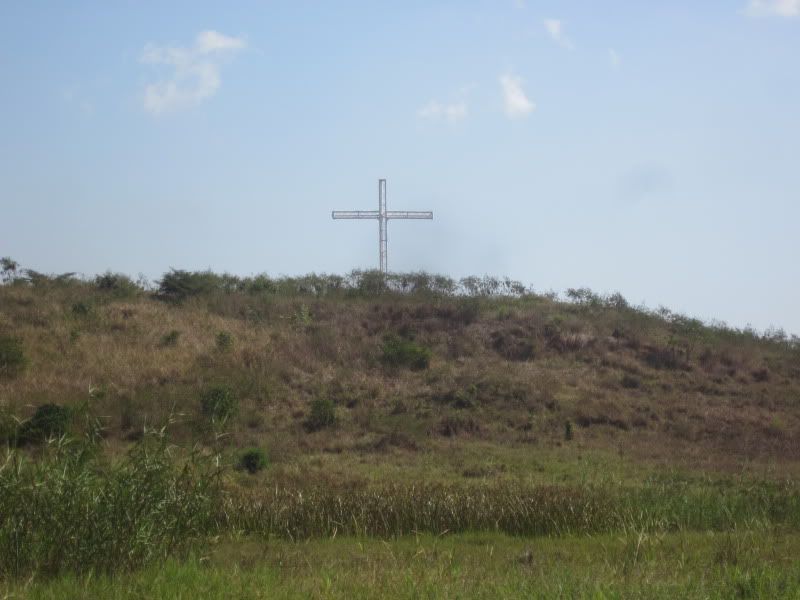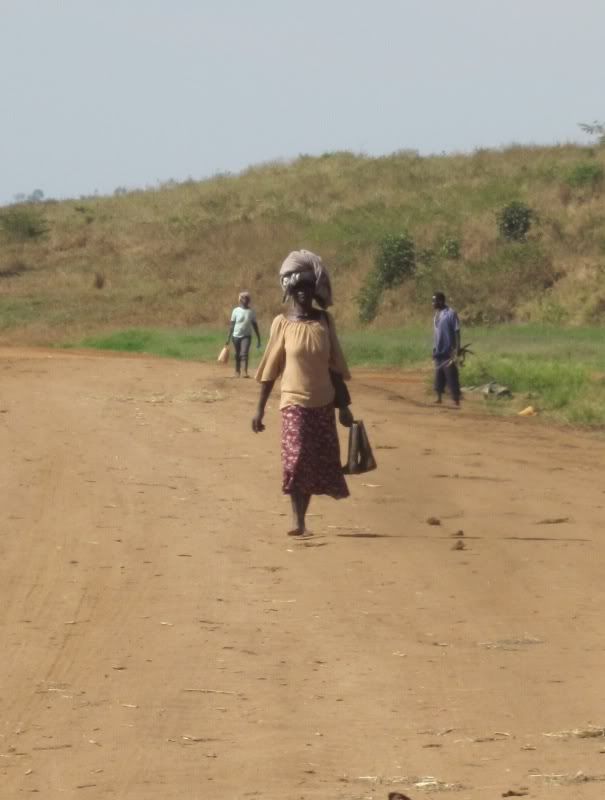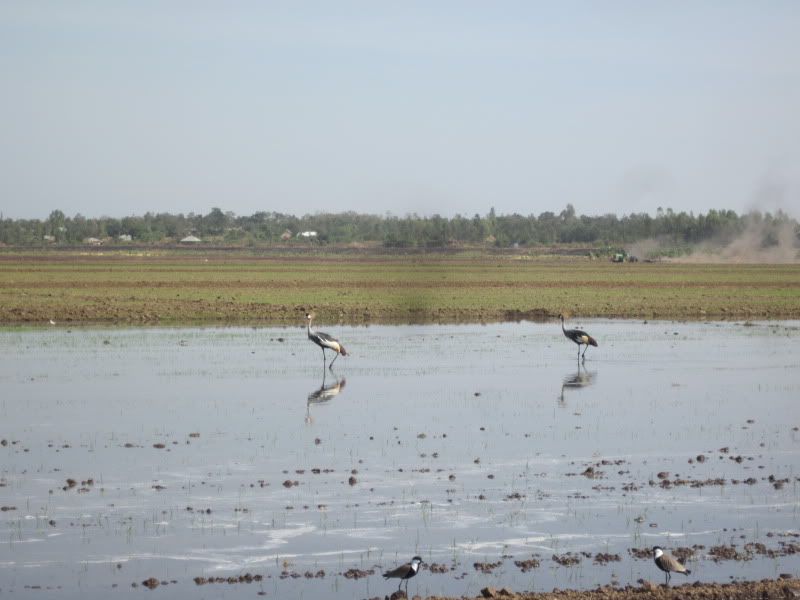
To get a tour of Dominion Farms, you need an appointment. Malaki's cousin used to work at Dominion, and he hooked Amy and Malaki (my hosts) up with a contact there, who gave them an appointment.
We drove from Malaki's village to Dominion, arriving at a large, guarded gate on the Bondo side of the swamp. There was some confusion as we tried to get in. The guard did not want to let us in, it seemed, and Amy tried to call her contact's cell phone. He kept telling her he was busy with a big group of Nigerians, but as luck had it, he was right near us - and so were all of the Nigerians. As he talked to the guard and helped secure our admission, the Nigerians kept trying to take pictures of us strange-looking white people, shoving cameras right in our faces.
Once we were through the gate with instructions to go to the office to sign in, we were on our own. I had a smudge on my camera lens, but we could see - and I took pictures of - a combine in the field and a crop duster spraying god knows what from the sky.


Both outside and inside the gate, one could see people carrying water or other things on their heads. All around, we could see a diverse array of birds, which made me really excited to see them, and horrifically sad that they were losing their habitat and ingesting pesticides.


African spoonbill

Chemical sludge in the water

Crested Cranes. You always see them in pairs.

Not sure about the species of these

A kind of grainy close-up, in case someone else can recognize 'em

That dust cloud is NOT just the smudge on my camera lens. Is that simply exhaust fumes or is it the topsoil eroding away?
At last, we reached the office, which was just outside Dominion's Siaya gate.

Just outside the office, which has more security
For a tour, Dominion charges a hefty fee for each small tour bus, and more for a large tour bus. Amy tried to bargain the price down since we were just a small car with three adults and a baby, and because they were locals. Shouldn't locals have inexpensive access to see this farm that is right in their backyard? Apparently not. I paid the full fee for our "tour bus" of three people, Amy signed the guest book, and we were officially "in."
With that, a tour guide got in our car, and off we went. We might have been lucky because she was new - we were the first group she gave a tour to - and she wasn't very good at evading questions she wasn't supposed to answer. However, on the flipside, she also didn't know a lot of answers to questions we asked.
The guide - a very attractive woman who had recently graduated college - began by saying that in 2003, Calvin Burgess, the founder, began Dominion Farms. They began by clearing the land and preparing fields for rice farming. But before they were ready to do rice, they had a few other projects like growing maize that they did in the meantime. Once the land was ready for rice, they let the other projects go.
Guide: The reason we stopped growing maize is that the land on which you grow maize does not need as much preparation as the land on which you grow rice. So on your left, you see the rice, and you see the bananas? That's rice husk. We use it for mulching to get rid of the grass.
So basically, the rice milling we started in 2006 and it's been going on strong. So we have almost 4000 acres we've reclaimed. This was all a swamp. There used to be nothing here. It was just a total swamp. So we had to reclaim it. If you go to the weir, you'll see how we reclaimed it. We use the water for many things. There is rice. If you go this way, there is rice. There is, of course, fish, and that's basically it. And then there's domestic use on the other side. That is, like, houses.
Amy Lint: How many workers are here?
Guide: I'm not very sure but I think not more than 400.
AL: So everybody has housing on property or does some come from outside?
Guide: Most of them are the villagers.
AL: I mean, so they stay outside the compound?
Guide: Yeah, they stay in their homes.
AL: Some commute?
Guide: It's a very short distance, like 10 minutes. So they just walk from their houses.
Here, what you are seeing is a flooded field. It has been planted, and then after planting we put in water immediately. Then it stays for four to five days.

A just planted flooded rice field
Guide: Then we drain out the water and harden the crop. We let it get used to the sun, because we don't do wet farming. We do not put it in water from day 1 to the end. So that means if we do not harden it off, it may die easily. So after four to five days we drain it, leave it to harden for one month, we flash back water, and wait for it to mature.

An unflooded field being hardened off.
At this point, I was getting into my groove. I'd seen some rice in the Philippines but then I read an entire dissertation about the International Rice Research Institute, so I had a few questions for her...
Me: So you don't transplant?
Guide: No, we don't transplant. That's what we do back where I come from. Here we just do direct seeding.
[Historically, rice was always planted in a seedbed and then transplanted into the field. During the Green Revolution, IRRI was very interested in finding a way to direct seed the rice and skip the transplanting step. So the fact that they direct seed is interesting for that reason.]
Me: Do you use a machine, or do people do the direct seeding by hand?
Guide: We use machines. You'll see them. That's where we are going. The first stop will be machinery.
Me: Do you know the variety you grow?
Guide: Yes. It's a special breed that was actually made here. It's - okay, they are just numbers. It's 103 and 107.
Me: Are they early maturing?
[Another goal of the Green Revolution. If the rice matures quickly, then you can grow several crops on the same land each year.]
Guide: They take 120 days.
AL: So what are all these people doing here?
Guide: The ladies at the end? They are either gapping or weeding, but considering the field, they must be gapping. That means, once we have grown the seed and you drained off the water, there isn't 100% viability. Some seed doesn't grow. So there are some fields that we have to grow seedlings that we use to fill in the gaps so that we have a full crop. So that's what they are doing.
Me: So you do that by hand and weeding by hand?
Guide: Weeding is also done by hand.
Me: Do you also use some herbicides?
Guide: Yes. We have an integrated method of controlling weeds. That is the manual method of hand weeding, then there is the selective herbicide, and there is also the flooding. You know, rice is a friend of water, so it grows well in water. But other plants do not grow in water.
Me: Do you know which herbicides are the best ones to use?
Guide: Maybe we can ask somebody else. But there is a plane that is going around right now, and it is spraying the herbicides. It also sprays fungicides and fertilizer.
Me: All of that together?
Guide: No, we have a schedule.
AL: What's the schedule? How often?
Guide: We try to minimize the chemicals we use. But there is a pre-emergent and a post-emergent herbicide. That means before the weeds start to grow, then after the rice has started growing and the weeds as well.
So this is a harvester. We use a combined harvester. So here we've already harvested it. We may leave it like this and get another crop. It's called a rattoon. Or we may just cultivate it again and wait another 120 days. But if it's a rattoon, it only takes two months and the cost of production is much much lower.
Me: Is this ready to harvest?
Guide: Yeah, this is ready to harvest.

Mature rice

Stuff growing among the rice. I thought I saw something move in there and tried to see if it was a frog or something, but saw nothing.
AL: How many acres are under production at once? Do you use the same land every time or do you rotate?
Guide: We have to do rotation. When this harvest is ending, the next one is ready, so that the mill always has rice.
AL: And how many acres is under cultivation at one time?
Guide: Right now, we are harvesting like 10 fields and the acreage is like between 40 and 70 acres each field. And we are harvesting ten of them right now. And that will last us until the next harvest. So as you see, it's different stages. So there's a program that's used to run that.
So this is basically our machinery area. We have tractors. We have the disc plow, this is our lawn mower. We have serrated disc plows and just plain disc plows.
Let me just go through the land reclamation process. What happens, there's the really, really big ones. There's the bulldozers and the land planes that go and clear the land first of all. Then we go and till it, primary and secondary tillage. After that, maybe we go and dig the ground and then put in the seeds, and compact the soil so that it doesn't wash off the seeds.
Malaki Obado: How do you fuel it?
Guide: Oh yeah we have fueling stations, three of them.
MO: Within the farm?
Guide: Yes, within the premises. So a tanker comes and brings the fuel.
AL: For how long do you plan to grow rice here?
Guide: Umm, I don't think we are ever planning to stop.
AL: Like, who owns the land. Isn't it the Kenyan government?
Guide: Yes. I don't have access to the agreement, so I don't know how long.
Coming up in the next diary: Dominion's canals and weir, tilapia farming, and the mill.
No comments:
Post a Comment